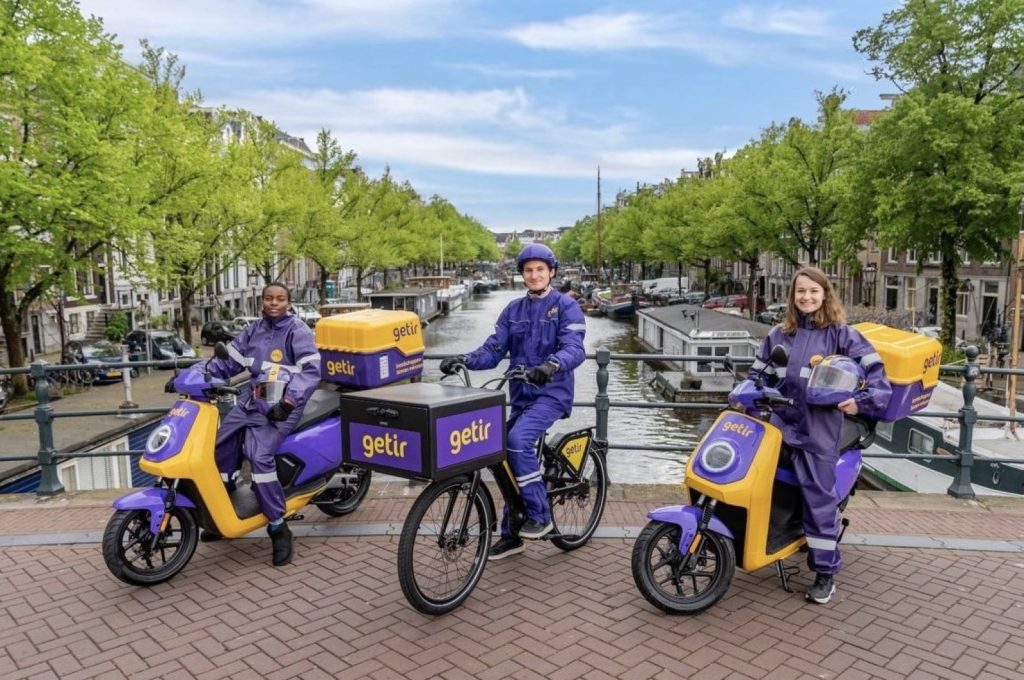
Just returned from the supermarket, ready to start the preparations for spaghetti Bolognese, you find out that you have forgotten to buy spaghetti. What to do anno 2021? Exactly, you grab your phone and swipe for the rapid grocery delivery service you are using. Rapid grocery delivery services are the new-established solution for sluggish students, parents being too busy handling their household tasks or just anybody interested in rapid grocery delivery. As these providers of groceries gain popularity, it’s interesting to investigate their business model and survival plan.
COVID-19
During the pandemic rapid delivery services have flourished. There was a group of elderly people or people with a bad immune system who averted the local supermarket. Then, there were the people who had to stay in quarantine and therefore were not doing groceries in the traditional way. For many people online grocery shopping became a new habit and rapid delivery services as Gorillas, Flink or Getir experienced a boost in sales (Steinmetz, 2021).
Business model
Instant delivery has gained popularity real fast as 4 out of 5 respondents had already heard of the concept. Even 40% of the respondents had already used one of the delivery services already.
According to experts it is important to grow rapidly and be the biggest operator as soon as possible. Only a few survivors will be able to make profit; at least when they raise their prices. At this moment all the different instant-delivery services order products for supermarket prices and ask hardly any additional costs for delivery. Some of them have just introduced a minimum ordering amount. This is an undoable situation as the costs outweigh the money which enters the company (van der Velden and Smit, 2021).
On top of that, the margins are incredibly low already at this stadium. The expectation is that these margins will only decrease as the competition will increase, as an increase in opponents does not only mean price competition but also a raise of the acquisition costs (Keswiel, 2021).
So as stated above, it is essential for flash delivery services to grow rapidly to make experience scale advantages and network effects.
Will it stick..?
The fact that 4 out of 5 people have heard about rapid delivery services and 40% of the respondents have even tried it already, shows that there is definitely a chance of success for instant delivery services. Essential is that they realize there is a possibility to raise their prices as their users are willing to pay for a forgotten product at their doorstep within 10 minutes… Welcome in 2021!
References
Keswiel, M., 2021. Maken flitsbezorgers zoals Gorillas een kans in Nederland? De uitdagingen zijn enorm. [online] MT/Sprout. Available at: <https://mtsprout.nl/startups-scaleups/maken-flitsbezorgers-zoals-gorillas-een-kans-in-nederland-dit-zijn-de-belangrijkste-uitdagingen> [Accessed 16 September 2021].
Steinmetz, J., 2021. Rapid delivery grocery apps have flourished during the pandemic – but will they permanently change how we shop?. [online] The Conversation. Available at: <https://theconversation.com/rapid-delivery-grocery-apps-have-flourished-during-the-pandemic-but-will-they-permanently-change-how-we-shop-162391> [Accessed 16 September 2021].
van der Velden, L. and Smit, R., 2021. Valt er wel iets te verdienen met flitsbezorging?. [online] FD.nl. Available at: <https://fd.nl/bedrijfsleven/1408292/valt-er-wel-iets-te-verdienen-met-flitsbezorging-opi1ca304bJQ> [Accessed 16 September 2021].

Interesting and on topic post Tim! Nowadays, we indeed see a lot of new businesses that are focusing on rapid grocery delivery services. I like that you used a new business case to show this upcoming and developing business model. It is interesting to see that some industries are more affected than others by digital offerings. In this case, this is probably due to the fact that this market was very attractive and easy to enter in the COVID-19 period. Furthermore, it is also fascinating to see that even though this industry is quite new, lots of people heard or already even used this concept. I believe that the switching cost were quite low in this market, since the adoption was high (in a very short period of time). The low switching costs combined with the fast adoption of this application actually influenced this disruption. Nice article to read and I am looking forward to where this is going in the future!
Very interesting read! Rapid delivery is definitely a big trend in the startup world right now. While those services are surely convenient, especially during bad weather, they are definitely having a hard time at differentiating themselves from another. Especially the grocery services have seemingly no switching costs, as their product offerings differ only minimally. Thus, they can only go over price reduction, which is already a difficult topic in the general grocery market, as you already put it, margins are generally very low. Therefore, it will be interesting to see, if the first movers like Getir, Gorillas or GoPuffs can maintain their market positions, as larger players are more and more entering the market. Definitely a topic to watch during the next years!